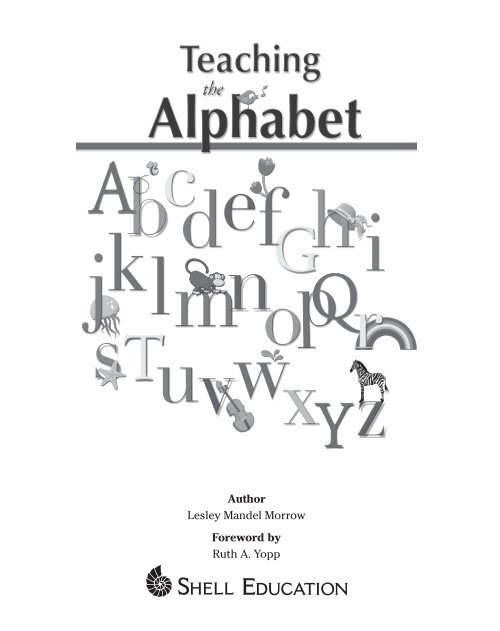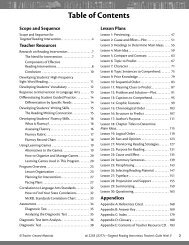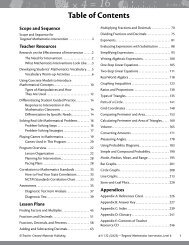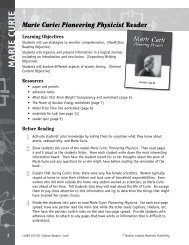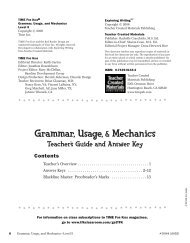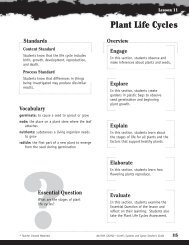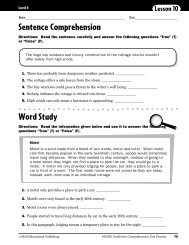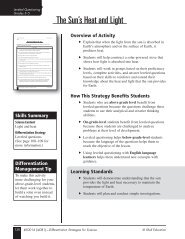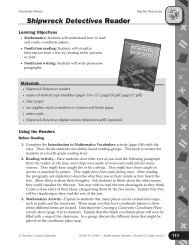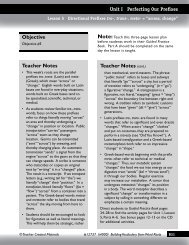Author Lesley Mandel Morrow Foreword by Ruth A. Yopp - Teacher ...
Author Lesley Mandel Morrow Foreword by Ruth A. Yopp - Teacher ...
Author Lesley Mandel Morrow Foreword by Ruth A. Yopp - Teacher ...
You also want an ePaper? Increase the reach of your titles
YUMPU automatically turns print PDFs into web optimized ePapers that Google loves.
<strong>Author</strong><br />
<strong>Lesley</strong> <strong>Mandel</strong> <strong>Morrow</strong><br />
<strong>Foreword</strong> <strong>by</strong><br />
<strong>Ruth</strong> A. <strong>Yopp</strong>
Table of Contents<br />
<strong>Foreword</strong> . . . . . . . . . . . . . . . . . . . . . . . . . . . . . . . . . . . . . . . . . 5<br />
Acknowledgements . . . . . . . . . . . . . . . . . . . . . . . . . . . . . . . . 7<br />
Introduction and Research . . . . . . . . . . . . . . . . . . . . . . . . . . 9<br />
The Motivation for This Book . . . . . . . . . . . . . . . . . . . . . 10<br />
Familiar Alphabet Activities . . . . . . . . . . . . . . . . . . . . . . 12<br />
Research Support . . . . . . . . . . . . . . . . . . . . . . . . . . . . . . . 13<br />
Overview of Chapters . . . . . . . . . . . . . . . . . . . . . . . . . . . 16<br />
Features of Teaching the Alphabet . . . . . . . . . . . . . . . . . 17<br />
Chapter 1: Creating a Literacy-Rich Classroom<br />
Environment . . . . . . . . . . . . . . . . . . . . . . . . . . . . . . . . . . . . . 21<br />
Designing Classroom Literacy Spaces . . . . . . . . . . . . . . 24<br />
The Classroom Library . . . . . . . . . . . . . . . . . . . . . . . . . . 27<br />
Choosing Books for the Library . . . . . . . . . . . . . . . . . . . 30<br />
Genres in the Classroom Library . . . . . . . . . . . . . . . . . . 32<br />
The Writing Center . . . . . . . . . . . . . . . . . . . . . . . . . . . . . . 41<br />
Letter-Recognition Materials in the Writing Center . . . 43<br />
Environmental Print . . . . . . . . . . . . . . . . . . . . . . . . . . . . . 44<br />
Reflection: In My Classroom . . . . . . . . . . . . . . . . . . . . . . 48<br />
Chapter 2: Building Children’s Alphabet Awareness . . 49<br />
Learning the Alphabet . . . . . . . . . . . . . . . . . . . . . . . . . . . 51<br />
Systematic Teaching of the Alphabet. . . . . . . . . . . . . . . 55<br />
Selecting Letters to Teach . . . . . . . . . . . . . . . . . . . . . . . . 60<br />
Reflection: In My Classroom . . . . . . . . . . . . . . . . . . . . . . 63<br />
3
Chapter 3: Activities for Teaching Letter Recognition. . 65<br />
Basic Lesson Plan for Teaching Letter Recognition. . . 68<br />
A Collection of Letter-Recognition Games . . . . . . . . . . 75<br />
Reflection: In My Classroom . . . . . . . . . . . . . . . . . . . . . . 86<br />
Chapter 4: Parents: Partners in Learning . . . . . . . . . . . . 87<br />
Communicating with Parents . . . . . . . . . . . . . . . . . . . . . 89<br />
Tips for Parents . . . . . . . . . . . . . . . . . . . . . . . . . . . . . . . . 94<br />
Reflection: In My Classroom . . . . . . . . . . . . . . . . . . . . . 102<br />
Chapter 5: Creating Personalized Alphabet Books . . . 103<br />
Directions for Making Personal Alphabet Books . . . . 104<br />
Reflection: In My Classroom . . . . . . . . . . . . . . . . . . . . . 108<br />
Chapter 6: Assessment Guides Instruction . . . . . . . . . . 109<br />
Assessing Children’s Alphabet Knowledge . . . . . . . . . 112<br />
Assessing Children’s Knowledge of Book Parts . . . . . 115<br />
Assessing Children’s Behavior in the<br />
Writing Center . . . . . . . . . . . . . . . . . . . . . . . . . . . . . . . 115<br />
Reflection: In My Classroom . . . . . . . . . . . . . . . . . . . . . 116<br />
Appendices . . . . . . . . . . . . . . . . . . . . . . . . . . . . . . . . . . . . . 117<br />
Appendix A: Reproducible Checklists . . . . . . . . . . . . . 118<br />
Appendix B: Resources for <strong>Teacher</strong>s and Families . . 132<br />
The Sensory Alphabet . . . . . . . . . . . . . . . . . . . . . . . 132<br />
The American Sign Language Alphabet . . . . . . . . . 133<br />
Template for Personal Alphabet Book . . . . . . . . . . 134<br />
Alphabet Letters Template. . . . . . . . . . . . . . . . . . . . 135<br />
Appendix C: Recommended Children’s Literature. . . 151<br />
Children’s Books for Recognizing Letters<br />
of the Alphabet . . . . . . . . . . . . . . . . . . . . . . . . . . . . . 151<br />
Children’s Books Categorized <strong>by</strong> Theme . . . . . . . . 164<br />
Appendix D: Online Resources . . . . . . . . . . . . . . . . . . . 169<br />
References Cited. . . . . . . . . . . . . . . . . . . . . . . . . . . . . . . . . 171<br />
Children’s Literature Cited . . . . . . . . . . . . . . . . . . . . . . . . 179<br />
Contributing <strong>Author</strong>s. . . . . . . . . . . . . . . . . . . . . . . . . . . . . 181<br />
4
lowercase is another key component of alphabet recognition.<br />
By the time children complete kindergarten and first grade,<br />
they should be able to perform all of these activities (Reutzel<br />
2010). As children develop the ability to recognize letters of<br />
the alphabet, they may incidentally learn some letter sounds.<br />
Some learning of letter sounds can occur in prekindergarten<br />
and should become more formalized in kindergarten and<br />
first grade. Although letter recognition is a key to reading<br />
success, other aspects of language are important in<br />
preschool literacy programs. Other skills, such as phonemic<br />
awareness, concepts about print, vocabulary, and listening<br />
comprehension, are all as important as letter recognition<br />
and should be taught concurrently (Reutzel 2010).<br />
Overview of Chapters<br />
Chapter 1: Creating a Literacy-Rich Classroom Environment<br />
describes a classroom that is designed to foster children’s<br />
interest in letters, words, and books. The library corner<br />
and writing center form the core of the activities designed<br />
to build children’s alphabet recognition. The chapter<br />
includes guidelines for choosing books for the library,<br />
descriptions of genres for the library, and suggestions for<br />
evaluating alphabet books and ebooks. The role of the<br />
writing center and the resources that make the center an<br />
effective place for letter-recognition activities is explained.<br />
The chapter concludes with a description of the role of<br />
environmental print in children’s literacy development.<br />
Chapter 2: Building Alphabet Awareness describes<br />
learning activities that facilitate children’s development of<br />
letter‐recognition skills. Several approaches to teaching the<br />
alphabet are presented, including Letter of the Week, Letter<br />
of the Day, and Letters in Thematic Units. The challenge<br />
of determining the sequence in which to teach letters is<br />
addressed, along with research-based recommendations.<br />
16
Chapter 3: Activities for Teaching Letter Recognition<br />
highlights a basic lesson plan for introductory lessons in<br />
letter recognition. Materials and procedures are described<br />
for each element of the lesson. This chapter features a<br />
collection of 10 letter-recognition games that provide<br />
review and practice in the context of interactive activities.<br />
Chapter 4: Parents: Partners in Learning discusses<br />
two important aspects of home-school relationships—<br />
communicating with parents and supporting parents in<br />
literacy-related activities they can do with their children.<br />
Chapter 5: Creating Personalized Alphabet Books is the<br />
capstone for Teaching the Alphabet. This chapter provides<br />
directions for creating personal alphabet books for children<br />
in your classroom. Modeled on the alphabet books I<br />
created for my grandchildren, the description includes a<br />
list of words to accompany each letter of the alphabet.<br />
Chapter 6: Assessment Guides Instruction offers ideas and<br />
checklists for observing and assessing children’s alphabet<br />
knowledge and how they apply this knowledge to various<br />
tasks and classroom settings.<br />
Features of Teaching the Alphabet<br />
This book provides practical suggestions for teaching<br />
alphabet recognition to young children. The importance of<br />
alphabet knowledge in children’s literacy development is<br />
underscored with selected references from research. The<br />
instructional activities follow a consistent pattern using<br />
materials that are readily available in early childhood<br />
classrooms. These activities are designed to provide<br />
many opportunities for children to be engaged with print,<br />
such as identifying letters, matching letters, talking about<br />
letters, and writing letters. Many teachers use alphabet<br />
books and other forms of children’s literature to extend<br />
17
their young children’s experiences with print. In these<br />
situations, children encounter print in meaningful contexts,<br />
an important component of effective literacy instruction.<br />
However, to ensure that children become proficient in<br />
their knowledge of the alphabet, teachers need to provide<br />
multiple opportunities for practice with letters in contexts<br />
that are most relevant to the children. Such activities form<br />
the core of Teaching the Alphabet.<br />
Each chapter of this book includes the following features:<br />
✿ References to research provide evidence of the<br />
important role of alphabet knowledge in young<br />
children’s literacy development.<br />
✿ “Viewpoint” boxes feature quotations that capture key<br />
themes about literacy development.<br />
✿ Classroom-tested activities provide multiple<br />
opportunities for children to practice alphabet<br />
recognition.<br />
✿ “Reflection: In My Classroom,” a feature at the end<br />
of each chapter, offers questions and comments that<br />
invite you to reflect on your teaching.<br />
Additionally, the appendices contain resources to support<br />
your teaching. The following resources to facilitate<br />
planning for instruction and guidance for communicating<br />
with parents are also provided:<br />
✿ The checklists and templates that accompany selected<br />
topics in the chapters.<br />
✿ The Sensory Alphabet presents familiar words for<br />
each of the senses—sight, hearing, touch, taste, and<br />
smell.<br />
✿ The American Sign Language Alphabet illustrates the<br />
hand signals for each alphabet letter.<br />
18
✿ Recommended Children’s Literature includes lists of<br />
children’s books categorized <strong>by</strong> alphabet letters and<br />
themes.<br />
✿ Suggestions of online resources that support parents<br />
and teachers as they teach the alphabet.<br />
19
letter, and matching letters to letters in their name. Child of<br />
the Day, a common practice in early childhood classrooms,<br />
provides additional practice in letter recognition. Children<br />
match letters to that child’s name or write the child’s name.<br />
(McGee 2007, 131–132). Figure 2.1 below presents guidelines<br />
for teaching letters.<br />
Figure 2.1 Guidelines for Teaching Letters<br />
Children’s<br />
Names<br />
Alphabetical<br />
Order<br />
Letter Name<br />
Pronunciation<br />
Letter<br />
Frequency<br />
Consonant<br />
Phoneme<br />
Acquisition<br />
Order<br />
Letter Writing<br />
Young children learn the letter names of the first<br />
initial in their given or first name (D for Dylan) and<br />
the other letters in that name more quickly and<br />
easily than letters that do not occur in the name.<br />
Young children learn the names of the letters<br />
at the beginning of the alphabet (a-b-c-d) more<br />
quickly and easily than the names of letters that<br />
appear later in the alphabet (e.g., l-m-n-o-p).<br />
Young children learn letter names earlier and more<br />
easily and quickly when the letter name contains<br />
the typical sound associated with the name<br />
(e.g., b /bē /; p /pē /; f /ef/; or m /em/) than those<br />
letter names that do not contain the typical sound<br />
associated with the letter (e.g., c /see/; g /gee/;<br />
h /ā ch/; q /cue/; w /double u/; y /wī/).<br />
Young children learn letter names more easily and<br />
quickly when these letters occur more frequently<br />
in print (e.g., n-r-s-t) than those that occur less<br />
frequently in print (e.g., q-x-z).<br />
Young children learn consonant letter names<br />
corresponding to consonant phonemes that are<br />
mastered earlier in oral language development<br />
(n-m-p-t-k) than those letters in which the<br />
corresponding phonemes are mastered later<br />
(l-r-z-sh-j).<br />
Young children learn letter names at a deeper and<br />
more lasting level when they learn to write the<br />
letters of the alphabet concurrently with learning<br />
the letter names.<br />
59
Basic Lesson Plan for Teaching<br />
Letter Recognition<br />
An introductory lesson for the whole group is an effective<br />
way to center children’s attention on the important<br />
features they need to learn about letters. Although new<br />
letters may be introduced in a Morning Message, the focus<br />
on the letters is incidental to the purpose of that routine.<br />
To ensure that children learn the letters, they need<br />
opportunities for explicit instruction, which is provided in<br />
whole-group lessons and followed up with small‐group and<br />
individual activities. A basic lesson plan for introductory<br />
lessons follows. The activities in this lesson plan would be<br />
conducted over several days or weeks, depending on the<br />
children’s learning needs.<br />
Introductory Lessons<br />
Note: Items marked with an asterisk are optional depending<br />
on children’s familiarity with the focus letters.<br />
Objectives: Children will<br />
✿ learn the name of the focus letter.<br />
✿ repeat the name of the focus letter with the teacher’s<br />
guidance.<br />
✿ match the appropriate letter to the teacher’s model.<br />
✿ identify (or write) the symbols for the uppercase and<br />
lowercase forms of the focus letter.*<br />
✿ listen to the sound the letter represents.*<br />
✿ say the sound the letter represents with the teacher’s<br />
guidance.*<br />
68
Materials:<br />
✿ letter card (large enough for all the children to see)<br />
✿ letter-picture card (e.g., B and picture of a ball)<br />
✿ letter cards for uppercase and lowercase forms of the<br />
letter<br />
✿ a set of letter cards for each child<br />
✿ container of mixed alphabet letters<br />
✿ whiteboard or chart paper<br />
✿ small dry erase boards and washable markers<br />
✿ copies of enlarged print page<br />
✿ highlighter tape<br />
Procedures:<br />
1. Begin <strong>by</strong> distributing a mat (or dry erase board and<br />
marker) and a container (e.g., envelope or plastic<br />
sandwich bag) of alphabet letters to each child.<br />
2. Show children how to spread out the letters so they<br />
can see all of them.<br />
3. Point out that you will be using chart paper (or a<br />
whiteboard) to show a letter to them.<br />
Explanation: Tell children that they will learn about a new<br />
letter.<br />
✿ They will learn the name of the letter.<br />
✿ They will say the name of the letter together.<br />
✿ They will find the letter in their set of letters.<br />
✿ They will write the letter in uppercase and lowercase<br />
form.<br />
✿ They will hear the sound the letter represents.<br />
✿ They will say the sound the letter represents.<br />
69


